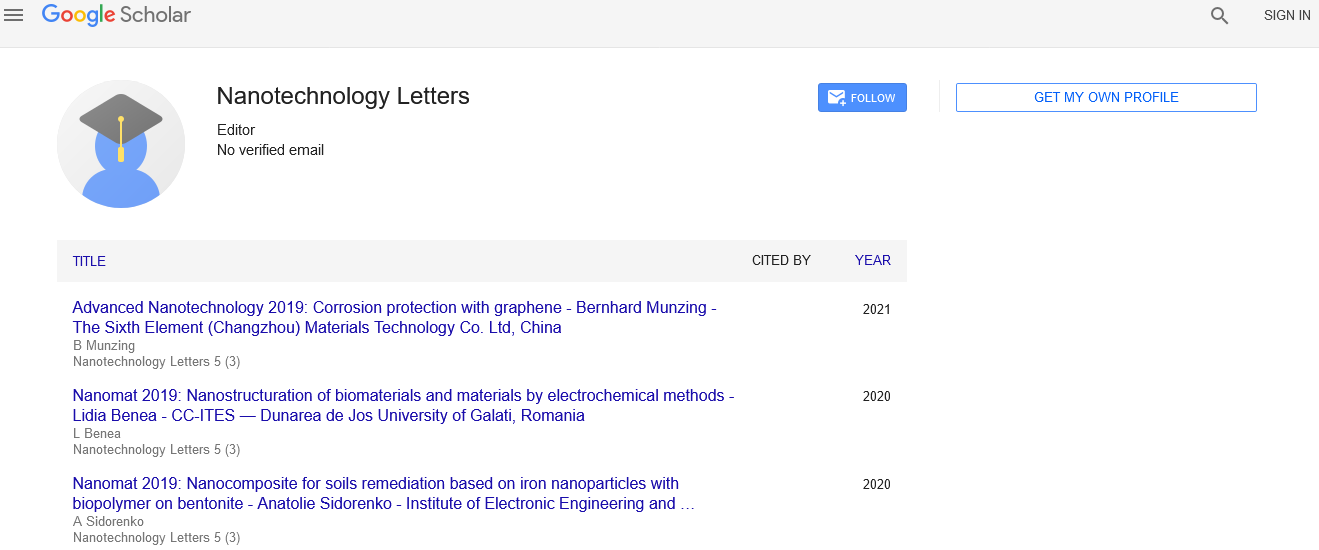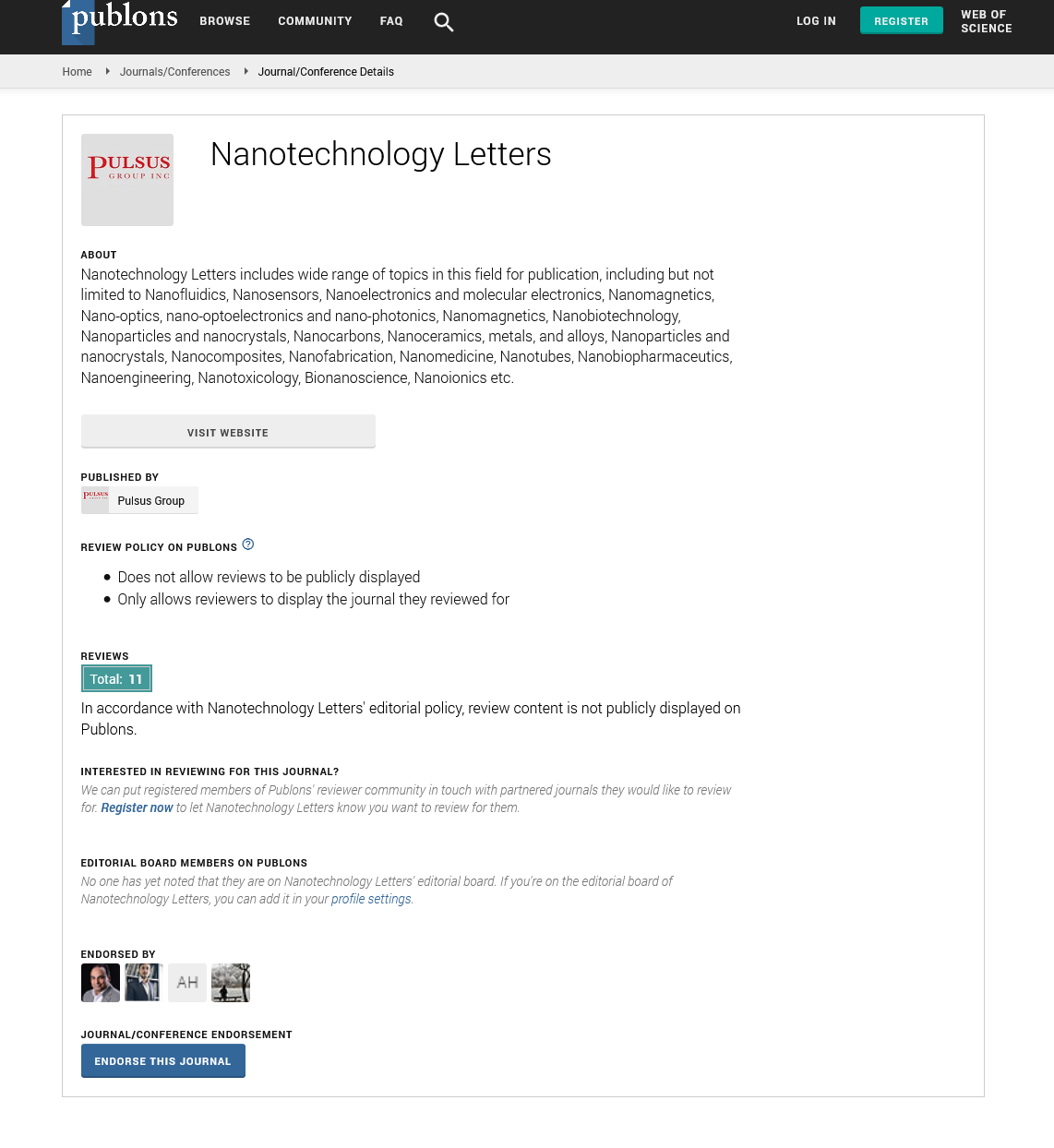Silver nanoparticles in chemistry
Received: 04-Mar-2022, Manuscript No. pulnl-22-4912; Editor assigned: 07-Mar-2022, Pre QC No. pulnl-22-4912(PQ); Reviewed: 22-Mar-2022 QC No. pulnl-22-4912(Q); Revised: 25-Mar-2022, Manuscript No. pulnl-22-4912(R); Published: 28-Mar-2022, DOI: 10.37532.pulnl.22.7.2.1-2.
Citation: Watson S. Silver nanoparticles in chemistry. Nanotechnol Lett. 2022; 7(2):1.
This open-access article is distributed under the terms of the Creative Commons Attribution Non-Commercial License (CC BY-NC) (http://creativecommons.org/licenses/by-nc/4.0/), which permits reuse, distribution and reproduction of the article, provided that the original work is properly cited and the reuse is restricted to noncommercial purposes. For commercial reuse, contact reprints@pulsus.com
Abstract
Nanoparticles are the fundamental building blocks of nanotechnology. Noble metals, such as Ag, Pt, Au, and Pd, are used to make nanoparticles nowadays. Nanoparticles, nanotubes, nanowires, and other nanometer-sized materials are being developed. Nanoparticles with unique capabilities in chemistry, optics, electronics, and magnetics, for example, have sparked a surge in interest in their creation. Topical ointments and lotions co-and lotions containing silver to prevent infection of burns and wounds are the most extensively used and well-known applications of silver nanoparticles. Physical and chemical procedures may also be successful in obtaining pure nanoparticles, but they are expensive and possibly hazardous to the environment.
Introduction
Nanoparticle research is currently an area of intense scientific investigation. Because of their high surface to volume ratio and outstanding conducting ability, silver nanoparticles have been widely used in the domains of chemistry and related branches. Silver nanoparticles are used in a variety of industries, from electrical switches to solar panels to chemical-producing catalysts and antibacterial action. Its one-of-a-kind qualities make it nearly impossible to duplicate, and its applications are diverse. At the same time, nanosilver is found in several consumer items that claim to incorporate nanoparticles. Computers, mobile phones, vehicle appliances, food packaging materials, food supplements, textiles, electronics, household appliances, cosmetics, medical devices, imaging techniques, and water and environment disinfectants are just a few examples of consumer products that contain nanosilver. The chemical, physical, optical, and electrical properties of nanomaterials are influenced by their size, shape, and surface morphology. Chemical reduction is one of the most frequent methods for producing silver nanoparticles using both inorganic and organic reducing agents. For the reduction of silver ions (Ag+) in aqueous or nonaqueous solutions, various reducing agents such as sodium citrate, ascorbate, sodium borohydride (NaBH4), elemental hydrogen, polyol process, Tollens reagent, N,N-dimethylformamide (DMF), and poly(ethylene glycol)-block copolymers, hydrazine, and ammonium formate are used. The reduction of silver nitrate with ethylene glycol in the presence of polyvinylpyrrolidone resulted in cubic silver nanoparticles (PVP). Ethylene glycol with hydroxyl groups serves as both a solvent and a reducing agent in the polyol process. The cubic form was created using polyvinylpyrrolidone as a capping agent. The form of the product is determined by the molar ratio of PVP and silver ions.
A microemulsion is made up of a combination of water, surfactant, and oil, or a combination of water, surfactant, and co-surfactant. The production of the microemulsion in the preparation of silver nanoparticles can be done with a variety of surfactants. Many surfactants, including anionic surfactants like bis(2-ethylhexyl) sulfosuccinate, sodium dodecyl benzene sulfonate, and lauryl sodium sulphate, cationic surfactants like cetyltrimethylammonium bromide, polyvinylpyrrolidone, and nonionic surfactants like Triton X-100, can be used to generate microemul water droplets coated with surfactant molecules operate as micro-reactors, providing a unique micro- environment for nanoparticle production.
Because of the growing need to develop environmentally friendly material synthesis processes, biosynthesis of nanoparticles has gotten a lot of attention. To give an example, the green synthesis of inorganic materials, particularly metal nanoparticles, utilising microbes and plant extracts has received a lot of attention. While microorganisms such as bacteria, algae, yeast, and fungi have been studied in the past for the intracellular and extracellular synthesis of metal nanoparticles, the use of plant components in nanoparticle synthesis approaches is a fascinating prospect that has just recently been researched. Bacillus amyloliquefaciens, Acinetobacter calcoaceticus, Pseudomonas aeruginosa, Escherichia coli, and Bacillus licheniformis have all been successfully employed to synthesise silver nanoparticles in the literature.
Many different plant extracts have been employed in the manufacture of silver nanoparticles in order to create Ag-NPs with various morphologies. The presence of a reducing agent in a plant-mediated synthesis of Ag-NPs, where the plant extract acts as a reducing agent, moulds the nanoparticle during its growth, according to TEM and SEM studies.






